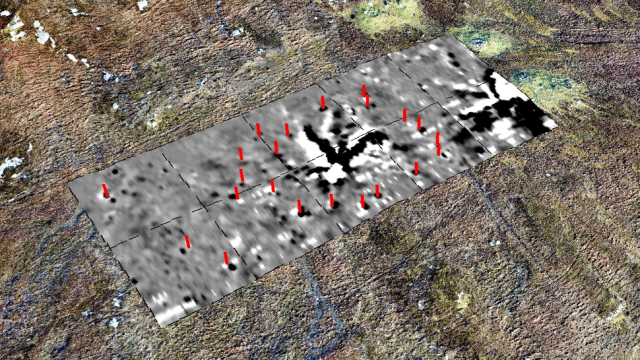Researchers working in the Outer Hebrides island chain off the west coast of Scotland have uncovered evidence of a previously unknown rock monument located within a stone’s throw of the iconic Calanais Standing Stones.
The newly discovered monument featured standing stones that were arranged in a circular pattern around a spot bearing the distinctive traces of a powerful lightning strike. Intriguingly, the new research indicates that the structure itself may have been deliberately built to attract lightning.
The discovery, made by researchers from the Calanais Virtual Reconstruction Project, suggests the stone monuments were somehow connected to, and possibly inspired by, powerful forces of nature. Lightning, it would appear, made quite the impression on the Neolithic people who lived at the time. Details of the discovery were recently published to the science journal Remote Sensing.
Archaeologist Richard Bates from the University of St. Andrews and his colleagues were looking for evidence of unknown rock circles buried beneath the ground near the Standing Stones of Calanais—a megalithic structure built some 5,000 years ago during the Neolithic period—on the Isle of Lewis. More than a dozen spots had previously been flagged as possible locations of “satellite circles” to the main monument.
These sites are now obscured by peat bogs that cover significant portions of the area. The researchers used multiple non-invasive remote sensing techniques, such as electromagnetic surface mapping and electrical resistivity tomography, to explore what was under the bogs. They uncovered evidence of a single standing stone at Calanais Site XI, or Airigh na Beinne Bige, which is located on a hill that overlooks the Calanais Great Circle. Geophysical analysis of the site shows that the lone stone was once part of a circle of standing stones.
What’s more, the scans revealed a rather large star-shaped “magnetic anomaly” at the centre of this circle, which was dated to around 4,000 years ago. This magnetic anomaly was formed by either a single, large lightning strike or a series of small strikes hitting the same spot, according to the new research.
“This evidence is rare because lighting strikes are conducted along the top ‘skin’ of the Earth’s surface,” Tim Raub, a co-author of the new study and a researcher from the University of St. Andrews, said in a press release. “The clarity of the strike suggests we are looking at events before the peat enveloped the site, more than 3,000 years ago.”
The researchers could not determine if the lightning strike (or strikes as the case may be) happened before or after the stone circle had been constructed.
In the same press release, Bates, who led the project, said the evidence of a lightning strike at the centre of this stone circle is “unlikely to be coincidental,” to which he added: “Whether the lightning at Site XI focused on a tree or rock which is no longer there, or the monument itself attracted strikes, is uncertain. However, this remarkable evidence suggests that the forces of nature could have been intimately linked with everyday life and beliefs of the early farming communities on the island.”
[referenced url=” thumb=” title=” excerpt=”]
That the megalithic monument could have been deliberately used to attract lightning strikes is a fascinating possibility—one warranting future research and consideration.
“The construction of a stone circle, deliberately located in a dominant position above the Calanais monument complex, might enhance the chances of such events,” the authors wrote, adding that “the archaeological literature increasingly recognises the symbiotic role between culture and nature in the past and, if that were the case at Site XI, this survey demonstrates the benefit of exploring buried landscapes of the western Hebrides through careful use of different remote sensing techniques.”
Typically, the construction of megalithic sites such as the Calanais Standing Stones are attributed to the changing seasons and the position of the Sun, among other reasons. The new research is interesting in that lightning—a previously under-appreciated natural phenomenon in the development of prehistoric sites—may have played an important role as well. The authors recommend archaeologists who study similar structures should be on the lookout for similar “magnetic anomalies” as well.
